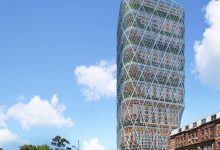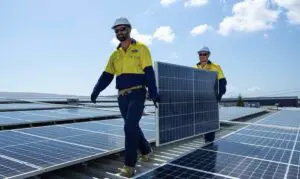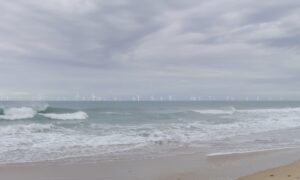Australian software billionaire Mike Cannon-Brookes has revealed more of the green details of the timber, steel, and solar-glass skyscraper that will serve as the new headquarters for his Nasdaq-listed company, Atlasssian, and form a pillar of Sydney’s new Tech Central Precinct.
In a series of Tweets on Thursday, Atlassian said the 40-storey tower would be the tallest hybrid timber building in the world and powered by 100 per cent renewable energy, including by building-integrated solar.
Incredibly proud of the whole @Atlassian workplace team ????????
The NSW Tech Central Precinct + our new building are precisely the sort of smart, green recovery project Australia ‘s economy needs.
The entire team has _nailed_ the brief ????????????????
A thread (1/4) pic.twitter.com/cqTWeEUkIF
— Mike Cannon-Brookes ???????????????? (@mcannonbrookes) June 24, 2020
Atlassian said the renewable energy to power the building would be generated both off-site – presumably via wind and solar PPAs – and on-site, via the building’s solar glass louvres.
Cannon-Brookes, who co-founded Atlassian with CEO Scott Farquhar, also said that the structure would have 50 per cent less embodied carbon in construction compared to other buildings its size, and consume 50% less energy per day.
“The NSW Tech Central Precinct and our new building are precisely the sort of smart, green recovery project Australia’s economy needs,” Atlassian tweeted on Thursday, noting that the precinct would generate 2,500 green construction jobs over the next four years.
NSW Premier Gladys Berejiklian, who on Thursday announced $48.2 million in funding to the initiative, said Tech Central would rival Silicon Valley and establish NSW as a global leader in innovation and technology.
“Technology and innovation are key planks of the government’s strategy to attract investment and create the jobs of the future for the people of NSW,” the Premier said.
“We have some brilliant tech innovators and entrepreneurs in our state and Tech Central will help us retain local talent and attractsome of the brightest minds in the world. This will be more important than ever as we recover from the pandemic.”
For Atlassian’s part, New York-based SHoP Architects and local firm BVN Architecture have co-designed the tower, which will be built next to Sydney’s Central Station.
The building will be divided into neighbourhoods, or “habitats”, with steel-and-concrete floor plates dividing the habitats, each of which will be four or five storeys high. Each habitat will also have its own garden setting, housed within Glulam timber columns and beams and cross-laminated timber floor slabs.
“This will be home to thousands of workers and the best new ideas. If you want to work in tech – this is the place you will want to be,” Atlassians Farquhar said.
“Sydney has the potential to be one of the world’s leading technology cities and the creation of a tech precinct sends a loud signal that we’re in the race to take a slice of the world’s most valuable market. That’s an exciting place to be.”
Cannon-Brookes has long been a vocal and generous supporter of all things sustainable, including his pivotal role in the installation of the Tesla big battery at Neoen’s Hornsdale wind farm which remains, for now, the first and biggest of its kind in the world.
Alongside mining magnate Andrew “Twiggy” Forrest, he has been one of the major financial backers of the Australia Singapore Power Link (ASPL), which aims to supply renewable electricity from a 10GW solar farm to both Darwin and Singapore via a high voltage direct current transmission line.
Cannon-Brookes has also been a vocal critic of lazy climate and energy policy, in 2018 launching a series of tweets challenging the Morrison government over its labelling of “baseload” and coal power as “fair dinkum” generation, and starting a “movement” to embrace wind and solar – and to dub that “fair dinkum power”.
In February, he teamed up with Tesla and Australian solar company 5B to create the Resilient Energy Collective, to provide stand-alone solar and battery storage systems to communities cut off by the summer’s bushfires and storms.
At the same time, Cannon-Brookes called for federal policy targets for transitioning to renewable energy and cutting emissions. “We have to have a target. A technology investment roadmap doesn’t remove need for a net-zero target. You have to have target and then have a series of solutions.”








